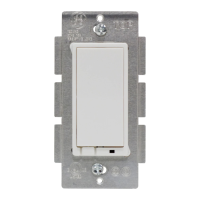Wireless Range
This device complies with the Z-Wave standard of open-
air, line of sight transmission distances of 65 feet. Actual
performance in a home depends on the number of walls
between the remote controller and the destination device,
the type of construction and the number of Z-Wave enabled
devices installed in the control network.
Ge Z-Wave Network
Every Z-Wave enabled device acts as a signal repeater and
multiple devices result in more possible transmission routes
which helps eliminate “RF dead-spots”.
Things to consider regarding RF range:
- Each wall or obstacle (i.e.: refrigerator, big screen TV, etc.)
between the remote or a Z-Wave device and the destination
device will reduce the maximum range by approximately
25-30%.
- Brick, tile or concrete walls block more of the RF signal than
walls made of wooden studs and plasterboard (drywall).
- Wall mounted Z-Wave devices installed in metal junction
boxes will suffer a significant loss of range (approximately
20%) since the metal box blocks a large part of the RF signal.

